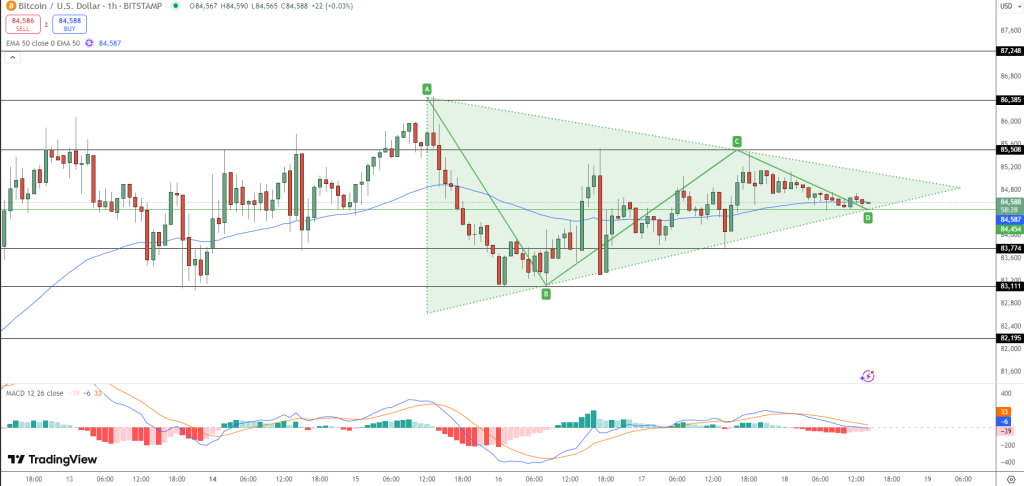Quantum Computing Challenges Bitcoin’s Stronghold: The QDay Prize
Bitcoin (BTC), with its robust $1.7 trillion network, stands as a titan in the world of cryptocurrencies, but its foundation rests on the tenets of elliptic curve cryptography (ECC). Once heralded as unbreakable, the security framework is now under scrutiny due to the rapid advancements in quantum computing. Enter Project 11, a pioneering quantum research firm that is shaking things up with a daring challenge: can you crack a simplified version of Bitcoin’s encryption using a quantum computer? If you succeed, you’ll be rewarded with 1 BTC, potentially worth around $85,000 at current prices.
The competition, known as the QDay Prize, invites teams to attempt breaking ECC keys ranging from 1 to 25 bits. While BTC utilizes a formidable 256-bit ECC, this challenge is far more symbolic than practical; however, the implications of such an endeavor could be monumental. Interested teams have until April 5, 2026, to showcase their skills and assess the real threats posed by quantum advancements.
“We just launched the Q-Day Prize. 1 BTC to the first team to break a toy version of Bitcoin’s cryptography using a quantum computer. Deadline: April 5, 2026. Mission: Protect 6M BTC (over $500B)— Project 11 (@qdayclock) April 16, 2025
Understanding the Quantum Threat
Why is the rise of quantum computing a cause for concern in the cryptocurrency community? Traditional computers would take centuries to crack Bitcoin’s encryption through brute force methods. However, a quantum computer can potentially shatter this paradigm in mere moments, thanks to Shor’s algorithm. This revolutionary mathematical formula turns the computational advantages of ECC into significant vulnerabilities.
Imagine a scenario where attackers could expose users’ private keys, forge signatures, and drain wallets—this isn’t just a plot twist from a futuristic sci-fi movie; it’s a tangible risk as quantum technology continues to mature. The urgency for adaptation is evident as even industry giants are taking precautions. For instance, Solana recently rolled out its Winternitz Vault, leveraging hash-based signatures resistant to quantum attacks. Similarly, Ethereum co-founder Vitalik Buterin has urged the development of a quantum-resistant hard fork for the Ethereum network.
Preparing for the Quantum Era
As of now, Bitcoin does not have active hard fork initiatives focused on quantum resistance. However, challenges like the one posed by Project 11 are stirring conversations and promoting readiness within the Bitcoin community. Alex Pruden from Project 11 emphasized, “We’re not trying to break Bitcoin, but if quantum computing can break even a small key, we need to prepare now.”
Why This Matters
The QDay Prize is more than just a competition; it serves as a critical stress test for the future of cryptocurrency security. Even a breach involving a 5-bit key would signal accelerated advancements in quantum computing that could undermine billions in crypto assets. The industry must take this as a wake-up call, signaling that proactive measures are imperative.
- Challenge Timeline: The contest runs until April 2026.
- Significance of Scaled-Down Keys: These keys are a symbolic yet practical approach to assessing quantum risks.
- Potential Risks: A real-world quantum breach could jeopardize billions of dollars in crypto value.
- Industry Response: Ethereum and Solana are leading the charge in quantum defense preparations.
As Pruden wisely stated, “We don’t know how far off ‘Q-Day’ really is. But when it arrives, we need to be ready.”
Current Bitcoin Market Trends
As the debate surrounding crypto security rages on, Bitcoin remains in a state of consolidation, currently oscillating around $84,588. The cryptocurrency has formed a symmetrical triangle on the 1-hour chart, indicating a potential breakout is imminent. Traders are watching closely as Bitcoin tests the apex of this triangle, maintaining a position above critical short-term support levels.

This compression pattern typically leads to a decisive price move, with resistance at $85,508. A breakout above this level could ignite a rally towards $86,385, while a downturn below $84,454 might plunge Bitcoin towards $83,774 or even $83,111. Current momentum indicators like the MACD are showing signs of weakening bullish trends, hinting at a cautious approach in the near term.
BTC Bull Token: Riding the Waves of Bitcoin’s Momentum
As Bitcoin approaches the psychological threshold of $85,000 amidst market volatility, the BTC Bull Token ($BTCBULL) is gaining traction among enthusiasts. This Ethereum-based token distinguishes itself by offering Bitcoin airdrops whenever BTC reaches significant price milestones, aligning perfectly with Bitcoin’s overarching growth narrative.
Investors are particularly attracted to its staking feature, enabling potential earnings of up to 86% APY. With the ability to unstake at any time, it offers unparalleled flexibility for both newcomers and seasoned traders alike.
Key Stats for BTC Bull Token
- Annual Yield: 86% APY
- Total Staked: 1,222,531,969 BTCBULL
- Unstake Anytime: Yes
With over 1.22 billion tokens staked and momentum building toward the next price milestone, the presale for BTCBULL has surpassed $4.77 million of its $5.47 million target. Currently priced at $0.002465, potential investors might want to act quickly as the supply dwindles and demand surges.

Conclusion: The Road Ahead for Crypto Security
As we delve deeper into the intricate world of cryptocurrency and the looming specter of quantum technology, it is clear that the stakes are high. Challenges like the QDay Prize not only test our current defenses but also highlight the need for continued innovation and vigilance. The evolution of Bitcoin and its associated technologies will depend significantly on our preparedness for the challenges that lie ahead. So, what will you do to stay informed and ahead in this fast-paced environment? Join the conversation, share your thoughts, and let’s navigate the future of crypto together.

